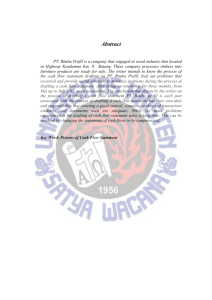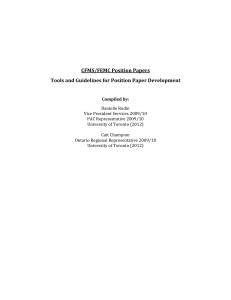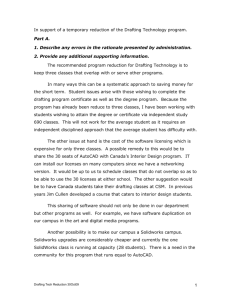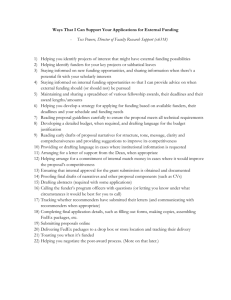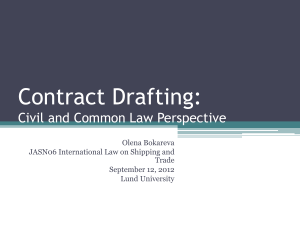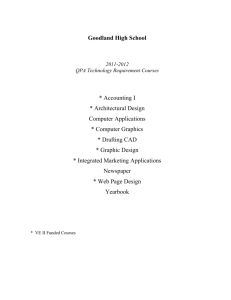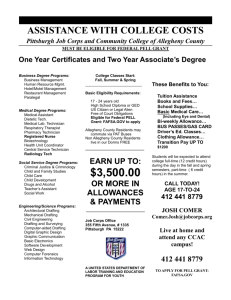legal drafting course syllabus - 2003
advertisement
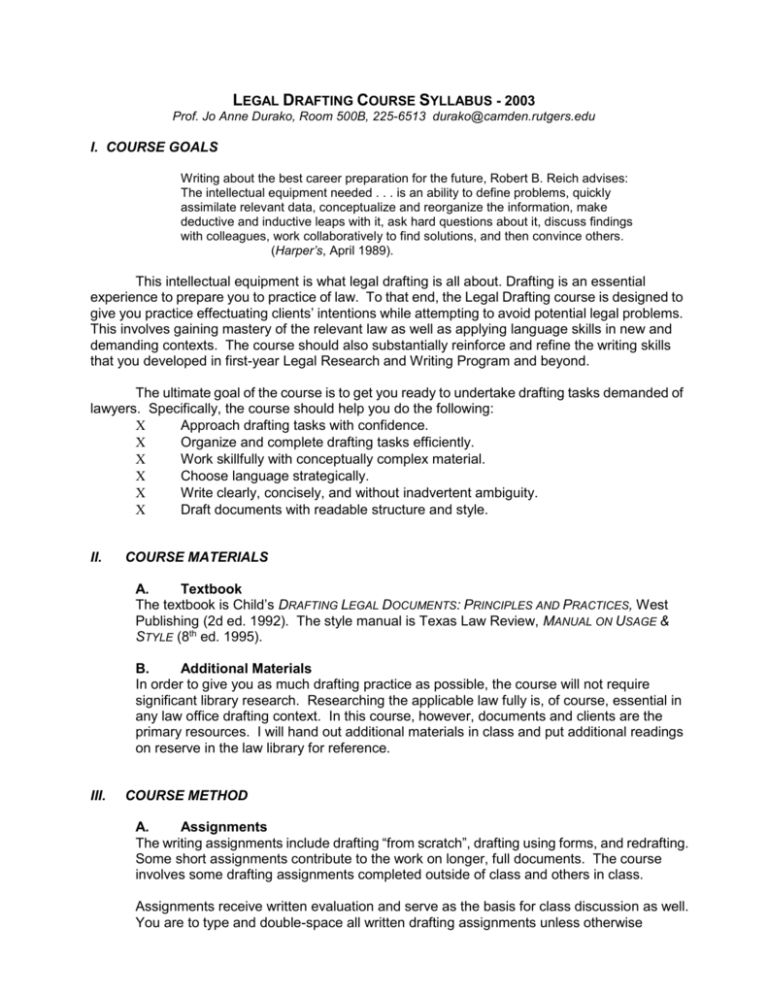
LEGAL DRAFTING COURSE SYLLABUS - 2003 Prof. Jo Anne Durako, Room 500B, 225-6513 durako@camden.rutgers.edu I. COURSE GOALS Writing about the best career preparation for the future, Robert B. Reich advises: The intellectual equipment needed . . . is an ability to define problems, quickly assimilate relevant data, conceptualize and reorganize the information, make deductive and inductive leaps with it, ask hard questions about it, discuss findings with colleagues, work collaboratively to find solutions, and then convince others. (Harper’s, April 1989). This intellectual equipment is what legal drafting is all about. Drafting is an essential experience to prepare you to practice of law. To that end, the Legal Drafting course is designed to give you practice effectuating clients’ intentions while attempting to avoid potential legal problems. This involves gaining mastery of the relevant law as well as applying language skills in new and demanding contexts. The course should also substantially reinforce and refine the writing skills that you developed in first-year Legal Research and Writing Program and beyond. The ultimate goal of the course is to get you ready to undertake drafting tasks demanded of lawyers. Specifically, the course should help you do the following: Approach drafting tasks with confidence. Organize and complete drafting tasks efficiently. Work skillfully with conceptually complex material. Choose language strategically. Write clearly, concisely, and without inadvertent ambiguity. Draft documents with readable structure and style. II. COURSE MATERIALS A. Textbook The textbook is Child’s DRAFTING LEGAL DOCUMENTS: PRINCIPLES AND PRACTICES, West Publishing (2d ed. 1992). The style manual is Texas Law Review, MANUAL ON USAGE & STYLE (8th ed. 1995). B. Additional Materials In order to give you as much drafting practice as possible, the course will not require significant library research. Researching the applicable law fully is, of course, essential in any law office drafting context. In this course, however, documents and clients are the primary resources. I will hand out additional materials in class and put additional readings on reserve in the law library for reference. III. COURSE METHOD A. Assignments The writing assignments include drafting “from scratch”, drafting using forms, and redrafting. Some short assignments contribute to the work on longer, full documents. The course involves some drafting assignments completed outside of class and others in class. Assignments receive written evaluation and serve as the basis for class discussion as well. You are to type and double-space all written drafting assignments unless otherwise instructed. Bring two copies of each assignment to class on the date due, one to turn in and the other to keep and have available during class discussion. B. Final Drafting Project There in no final examination in the course, but there is a final drafting project to be in progress during the last few weeks of the semester. It will be due before exams begin. IV. GRADES A. Basis: The course grade is based on: (1) the final drafting project 33% (2) selected individual assignments 15% (3) selected collaborative class assignments 45% (4) class participation. 7% B. Final Drafting Project The course grade is based substantially on the final drafting project. This project is designed to give you the opportunity to show you have mastered all the drafting principles and skills covered in the course; it assumes reasonably well developed writing skills. To pass the course, you must not have serious writing deficiencies in the final project. C. Assignments There will be both individual and group assignments. You will work with the same drafting partner for all group projects. You should choose a partner with complementary writing skills and work habits. All writing assignments throughout the course – those done in class as well as those done outside – are required. If you fail to turn in assignments on time and completed satisfactorily, your score will reflect that. D. Attendance and Participation Attendance and participation are required. Participation consists of more than mere attendance. Actual participation occurs when you: show you have prepared by reading and thinking about assigned materials; show you understand or are making an effort to understand the concepts and principles discussed; ask clear questions and build on others’ contributions; make connections between different subjects discussed; use the material to generate your own insights and applications; exhibit willingness to experiment with new skills and approaches to material; and make one professional class presentation, with your partner, on a written assignment. You are encouraged to participate as fully as possible in the classroom discussion. Since this is a limited enrollment seminar your participation is essential. V. ACADEMIC HONESTY GUIDELINES (We will redraft this.) Drafting work should be your own work product, unless an assignment is a collaborative work. An assignment merely copied from a form book is inadequate. While you may discuss all assignments, the written work product must be exclusively your own for all non-collaborative work. You may not discuss the final drafting project. LEGAL DRAFTING SYLLABUS - SPRING 2003 WEEK 1 INTRODUCTION TO LEGAL DRAFTING: DRAFTING AS A PROCESS Jan. 6 Read Text: Introductions pp. 1-5, 285-86, begin Chapter 9. Complete Legal Writing Skills Self-Test (in handout) and check your answers. Begin collecting good and bad examples of legal drafting for class discussion (leases, student loan documents, credit card agreements, law school rules). WEEK 2 LEGAL DRAFTING STYLE: CHOICE OF LANGUAGE; VAGUENESS, AMBIGUITY, DESIGN Jan. 13 Read Text: Review Chapter 9, read Chapter 8 and pages 399-407 in Chapter 11. Prepare Exc. 9.1, 9.2, 9.3 (review for price language only), 9.5 (9.5 for discussion). Download SEC Plain English Handbook, and skim Chpt. 4, 6, 7, App. A & B. (<http://www.sec.gov/investor/pubs/englishhndbk.htm) Prepare Exc. 8.1 and 8.2; Books and Records Exc. in handout. WEEK 3 WILLS; REVIEW THE LAW. Jan. 20 Read Text: Chapter 6 and New Jersey materials on wills. Prepare Exc. 6.1 (use working words), 6.2, 6.3, 6.5, 6.6 (6.6 for discussion only). Draft codicil individually, Assgn. 6A (5 points). WEEK 4 WILLS & USING CLIENTS AND DOCUMENTS AS RESOURCES; INTERVIEW CLIENT Jan. 27 Read Text: Chapter 7. Discuss draft codicil. In-class presentation. Prepare list of questions for client , Exc. 7.1 for Eleanor Stacey, Assgn. 6D Simulated client interview. Draft will w/ partner, Assgn. 6D (10 points). Use checklist on p. 272. WEEK 5 WILLS AND DIRECTIVES TO PHYSICIANS Feb. 3 Discuss draft will. In-class presentation. Complete timed will drafting assignment individually (MPT; 20 points). WEEK 6 LIMITS OF FORMS AND BOILERPLATE; DEVELOPING QUESTIONS FOR CLIENTS Feb 10 Guest Speaker: Prof. Susan King: Drafting Resources in the Law Library and on Internet. Prepare Exc. 7.3 & 7.4. WEEK 7 CONTRACTS Feb. 17 Read Text: Chapter 4. Prepare Exc. 4.1, 4.2, 4.3, 4.6, 4.7, 4.8, 4.9. Redraft retainer letter w/ partner, in handout (10 points). WEEK 8 CONTRACTS, CONT. - LEASES Feb. 24 Bring your lease or a sample lease to class. Redraft lease w/ partner, Assgn. 4D (20 points). Review contract for new business (Owner & Buyer), in handout, for discussion. WEEK 9 EMPLOYMENT CONTRACTS - SPECIAL PROVISIONS, CONFIDENTIAL INFO, NON-COMPETE Mar. 3 Review lease redraft for opposing counsel. Prepare list of section headings w/ partner, Assgn. 4F. Prepare drafting outline for employment contract w/ partner, Exc. 21 in handout. WEEK 10 CONFERENCES AND CATCH UP Mar. 10 SPRING BREAK WEEK 11 COMPLETE CONTRACT DRAFTING; COMPLETE STYLISTIC CHOICES Mar. 24 No class meetings this week. Read Text: 375-99 (finish chapter 11). Draft disclosure agreement w/partner, Exc. 20 in handout (10 points). Critique adversary draft (5 points). Negotiate with opposing counsels. Redraft negotiated agreement (5 points). WEEK 12 DEFINING TERMS; LEGISLATIVE DRAFTING Mar. 31 Read Text: Chapters 10 and 5; review Chapter 9. Discuss nondisclosure agreements and negotiation process. In-class presentation. Prepare for discussion Exc, 10.2 -10.4, 10.6 Exc. 5.2, 5.3, 5.8; Assgn. 5B, 5C. WEEK 13 LEGISLATIVE DRAFTING Apr. 7 Redraft legislation w/ partner, use checklist for definitions, p. 373, and checklist of legislation on p. 227 (10 points). In-class presentation. Discuss redraft of legislation (NJ Family Leave Act). In-class presentation. Final Drafting Project assigned Guest Speaker on Final Drafting project/or ¿questions to client submitted? WEEK 14 LEGISLATIVE DRAFTING FINISHED; ETHICS; WRAP UP; FINAL DRAFTING PROJECT Apr. 14 Draft headings for Final Drafting Project Questions to client answered WEEK 15 FINAL DRAFTING PROJECT DUE; COURSE EVALUATION Apr. 21 Final Project due 12:30, room 202. Final class meeting 4/22. Final project due; Course Evaluation Please regard this syllabus as the general plan for the semester, but understand it may be modified as needed.

